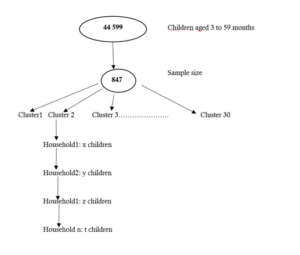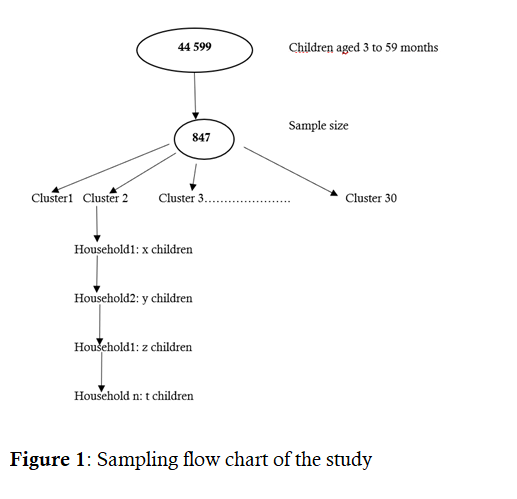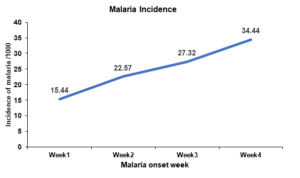Research | Volume 8, Article 6, 26 Mar 2025
Epidemiology of Malaria Cases, Sunyani Municipality, Ghana, 2020
1Ghana Field Epidemiology and Laboratory Training Program, University of Ghana School of Public Health, Accra, Ghana, 2School of Public Health, University of Ghana, Legon, Accra, Ghana, 3Ghana Health Service, Ministry of Health, Accra, Ghana, 4Sunyani Municipal Health Directorate, Sunyani, Bono Region, Ghana
Received: 08 Dec 2023 – Accepted: 10 Jan 2025 – Published: 10 Jan 2025
Domain: Field Epidemiology
Keywords: Chemoprevention, adherence, incidence, malaria, Tenkodogo, Burkina Faso
©Yewayan Larba Berenger Kabore et al Journal of Interventional Epidemiology and Public Health (ISSN: 2664-2824). This is an Open Access article distributed under the terms of the Creative Commons Attribution International 4.0 License (https://creativecommons.org/licenses/by/4.0/), which permits unrestricted use, distribution, and reproduction in any medium, provided the original work is properly cited.
Cite this article: Yewayan Larba Berenger Kabore et al . Factors contributing to preventing malaria in children aged 3 to 59 months after the first cycle of seasonal malaria chemoprevention in Tenkodogo Health District of Burkina Faso, July 2020: A prospective cohort study. Journal of Interventional Epidemiology and Public Health. 2025;8:1.
Available online at: https://www.afenet-journal.net/content/article/8/1/full
Abstract
Introduction: Malaria is endemic in Ghana, accounting for about 40% of all Outpatient Department (OPD) diagnoses. Data on malaria is routinely collected as part of the IDSR monthly reporting forms. Sunyani municipality recorded 56,540 malaria cases in 2016 with about 35% of the cases occurring in children under five years of age. We analyzed malaria surveillance data to identify the distribution of malaria cases by person, place, and time and determine the timeliness and completeness of malaria report submissions in the municipality.
Methods: We analyzed malaria surveillance data in Sunyani municipality reported between 2015 and 2019 from the District Health Information Management System (DHIMS 2). We calculated morbidity and mortality rates of cases by person and estimated the proportion of cases by sub-districts. We performed trend analysis and calculated disease threshold levels. We presented the findings using tables and figures.
Results: Of 639,361 malaria cases suspected, 93.5% (597512/639361) were tested, of which 49.4% (295458/597512) were positive. Females accounted for 55.7% (164436/295458) of confirmed cases. Children under 5 years recorded the highest proportion, 29.9% (88135/295458) of cases in the municipality. The case fatality rate was 3.7% (18/484) and 1.4% (7/484) for persons under five years and five or more years, respectively. Abesim subdistrict (6276.03 per 10000) recorded the highest number of cases, and the lowest case count was in New Dormaa subdistrict (1890.97 per 10000). The majority of malaria cases were in May and October of each year. Antwi-krom subdistrict recorded the highest rates of report completeness and timeliness at 41.9% and 40.0% respectively.
Conclusion: More females were diagnosed with malaria and children <5 years recorded the highest proportion of cases in the municipality. Abesim recorded the highest proportion of malaria cases during the period. High patterns of malaria transmission occurred during months of high rainfall. None of the sub-districts met the World Health Organization (WHO) target for timeliness and completeness of report submission. The National Malaria Elimination Programme (NMEP) should consider interventions such as Seasonal Malaria Chemoprevention (SMC) among children under five, in the municipality.
Introduction
In 2018, 228 million cases of malaria were reported globally, with an estimated 405,000 malaria-related deaths. The WHO African Region accounted for 94% of all these deaths [1]. Particularly vulnerable to malaria are pregnant women and children under five years [2]. The illness claims a child´s life every 2 minutes, making it the second-largest cause of death from infectious diseases in Africa [3]. About 67% (272, 000) of all malaria-related deaths in 2018 occurred in children under five years of age [1].
Malaria remains a hyperendemic disease posing a significant public health challenge in Ghana [4,5]. It is the leading cause of morbidity and mortality despite the scale-up of new malaria preventive and control interventions [6,7]. In 2020, the country recorded over 5.2 million confirmed cases of malaria with 308 malaria-associated deaths [8]. Malaria transmission is generally stable in Ghana with varying endemicity across the regions in Ghana. Malaria Indicator Survey 2019 showed a parasite prevalence of 14.1%, a decrease from 27.5% in 2011 with prevalence ranging from approximately 2.4% in Greater Accra to 27.0% in the Western Region [9].
Various malaria control interventions such as mass and school-based distribution of insecticide-treated nets and intermittent preventive treatment of malaria among pregnant women have been implemented in the Bono region to control the burden of malaria. Despite these measures, there is still a high malaria burden in the area [10]. Sunyani municipality recorded an upward trend of malaria cases from 43,467 in 2013 to 56,540 cases in 2016, with about 35% of the cases occurring in children under five [11]. Malaria morbidity and mortality data in the municipality is collected through the passive surveillance approach. Even with the malaria surveillance system in the municipality, there has been limited epidemiological analysis of the data gathered to inform decision-making on malaria preventive and control measures. We thus analyzed the five years´ malaria morbidity and mortality data to determine the distribution of malaria cases by person, place and time and to determine the timeliness and completeness of malaria report submission in the municipality.
References
- World Health Organization. World malaria report 2020: 20 years of global progress and challenges [Internet]. Geneva (Switzerland): World Health Organization; 2020 Nov 30[cited 2025 Jan 8]. 246 p. Download 9789240015791-eng.pdf. PubMed | Google Scholar
- Word Health Organization. Malaria [Internet]. Geneva (Switzerland): Word Health Organization; 2024 Dec 11 [cited 2024 Nov 26]. PubMed | Google Scholar
- Ministère de la Santé (Burkina Faso). Annuaire statistique 2018 [Statistical Directory 2018] [Internet]. Ouagadougou (Burkina Faso) : 2019 Apr [cited 2024 Nov 22]. 494 p. French. Download French annuaire_ms_2018.pdf. Published with the support of UNICEF. PubMed | Google Scholar
- Ministère de la Santé (Burkina Faso). Profil du Burkina Faso sur le paludisme [Burkina Faso malaria profile] [Internet]. Ouagadougou (Burkina Faso): Ministère de la Santé ; 2023 Dec [cited 2024 Dec 11]. 73 p. French. Download mshp_profil_du_burkina_sur_le_paludisme.pdf. PubMed | Google Scholar
- Organisation mondiale de la Santé. Chimioprévention du paludisme saisonnier par administration de sulfadoxine-pyriméthamine et d´amodiaquine aux enfants : guide de terrain [Seasonal malaria chemoprevention with sulfadoxine-pyrimethamine plus amodiaquine in children: a field guide] [Internet]. Geneva (Switzerland): Organisation mondiale de la Santé; 2013 Jul [cited 2024 Sep 20]. 45 p. French. Download 9789242504736_fre.pdf. PubMed | Google Scholar
- World Health Organization. Seasonal malaria chemoprevention with sulfadoxine-pyrimethamine plus amodiaquine in children: a field guide [Internet]. 2nd ed. Geneva (Switzerland): World Health Organization; 2023 May 26 [cited 2024 Nov 28]. 49 p. Download 9789240073692-eng.pdf. PubMed | Google Scholar
- Ministère de la Santé (Burkina Faso). Annuaire Statistique du ministère de la santé 2020 [Statistical Directory of the Ministry of Health 2020] [Internet]. Ouagadougou (Burkina Faso) : Ministère de la Santé ; 2021 Apr [cited 2024 Sep 20]. 472 p. French. Download annuaire_statistique_ms_2020_signe.pdf. PubMed | Google Scholar
- Dicko A, Diallo AI, Tembine I, Dicko Y, Dara N, Sidibe Y, Santara G, Diawara H, Conaré T, Djimde A, Chandramohan D, Cousens S, Milligan PJ, Diallo DA, Doumbo OK, Greenwood B.Intermittent Preventive Treatment of Malaria Provides Substantial Protection against Malaria in Children Already Protected by an Insecticide-Treated Bednet in Mali: A Randomised, Double-Blind, Placebo-Controlled Trial. PLoS Med [Internet]. 2011 Feb 1 [cited 2025 Jan 8];8(2):e1000407. https://doi.org/10.1371/journal.pmed.1000407 PubMed | Google Scholar
- Diawara F, Steinhardt LC, Mahamar A, Traore T, Kone DT, Diawara H, Kamate B, Kone D, Diallo M, Sadou A, Mihigo J, Sagara I, Djimde AA, Eckert E, Dicko A. Measuring the impact of seasonal malaria chemoprevention as part of routine malaria control in Kita, Mali . Malar J [Internet]. 2017 Aug 10 [cited 2025 Jan 8];16(1):325. https://doi.org/10.1186/s12936-017-1974-x PubMed | Google Scholar
- Coldiron ME, Assao B, Guindo O, Sayinzoga-Makombe N, Koscalova A, Sterk E, Quere M, Ciglenecki I, Mumina A, Atti S, Langendorf C, Grais RF.Prevalence of malaria in an area receiving seasonal malaria chemoprevention in Niger . Malar J [Internet]. 2021 Oct 24 [cited 2025 Jan 8];20(1):419. https://doi.org/1186/s12936-021-03953-2 PubMed | Google Scholar
- Institut National de la Statistique et de la démographie (Burkina Faso).RÉSULTATS CINQUIEME RECENSEMENT GENERAL DE LA POPULATION ET DE L´HABITATION 2019: MONOGRAPHIE DE LA REGION DU CENTRE-EST [RESULTS FIFTH GENERAL CENSUS OF POPULATION AND HOUSING 2019: MONOGRAPH OF THE CENTRAL-EAST REGION] [Internet]. Ouagadougou (Burkina Faso): Institut National de la Statistique et de la démographie (Burkina Faso) ;2022 Dec [cited 2025 Jan 8]. 172 p. French. Download MONOGRAPHIE DU CENTRE-EST 5E RGPH.pdf. PubMed | Google Scholar
- Ministère de la santé (Burkina Faso). Plan stratégique national de lutte contre le paludisme 2016-2020 [National strategic plan to combat malaria 2016-2020] [Internet]. Ouagadougou (Burkina Faso) : Ministère de la santé; 2016 Oct [cited 2025 Jan 8].137 p. French. Download BKF-501.1_ Plan Strategique National de Lutte Contr. pdf. PubMed | Google Scholar
- Salissou I, Mahaman Moustapha L, Yerima B, Alkassoum I, Hadiza D, Ibrahim ML.Perception de la chimioprévention du paludisme saisonnier au Niger [Perception of seasonal malaria chemoprevention in Niger] . Int J Bio Chem Sci [Internet]. 2017 Apr 25 [cited 2025 Jan 8];10(6):2710. French. https://doi.org/10.4314/ijbcs.v10i6.24 Download pdf to view full text. PubMed | Google Scholar
- Cissé B, Sokhna C, Boulanger D, Milet J, Bâ EH, Richardson K, Hallett R, Sutherland C, Simondon K, Simondon F, Alexander N, Gaye O, Targett G, Lines J, Greenwood B, Trape JF. Seasonal intermittent preventive treatment with artesunate and sulfadoxine-pyrimethamine for prevention of malaria in Senegalese children: a randomised, placebo-controlled, double-blind trial . Lancet [Internet]. 2006 Feb 25 [cited 2025 Jan 8];367(9511):659-67. https://doi.org/10.1016/s0140-6736(06)68264-0 Subscription or purchase required to view full text. PubMed | Google Scholar
- Dicko A, Sagara I, Sissoko MS, Guindo O, Diallo AI, Kone M, Toure OB, Sacko M, Doumbo OK. Impact of intermittent preventive treatment with sulphadoxine-pyrimethamine targeting the transmission season on the incidence of clinical malaria in children in Mali. Malar J [Internet]. 2008 Jul 8 [cited 2025 Jan 8];7(1):123. https://doi.org/10.1186/1475-2875-7-123 PubMed | Google Scholar
- Wilson AL. A Systematic Review and Meta-Analysis of the Efficacy and Safety of Intermittent Preventive Treatment of Malaria in Children (IPTc) . PLOS ONE [Internet]. 2011 Feb 14 [cited 2025 Jan 8];6(2):e16976. https://doi.org/10.1371/journal.pone.0016976 PubMed | Google Scholar
- Hategeka C, Tuyisenge G, Bayingana C, Tuyisenge L.Effects of scaling up various community-level interventions on child mortality in Burundi, Kenya, Rwanda, Uganda and Tanzania: a modeling study. Glob Health Res Policy. 2019 May 29 [cited 2025 Jan 8];4(1):16. https://doi.org/10.1186/s41256-019-0106-2 PubMed | Google Scholar
- Miller JS, English L, Matte M, Mbusa R, Ntaro M, Bwambale S, Kenney J, Siedner MJ, Reyes R, Lee PT, Mulogo E, Stone GS.Quality of care in integrated community case management services in Bugoye, Uganda: a retrospective observational study . Malar J [Internet]. 2018 Feb 27 [cited 2025 Jan 8];17(1):99. https://doi.org/10.1186/s12936-018-2241-5 PubMed | Google Scholar
- Altaras R, Montague M, Graham K, Strachan CE, Senyonjo L, King R, Counihan H, Mubiru D, Källander K, Meek S, Tibenderana J. Integrated community case management in a peri-urban setting: a qualitative evaluation in Wakiso District, Uganda . BMC Health Serv Res [Internet]. 2017 Nov 28 [cited 2025 Jan 8];17(1):785. https://doi.org/10.1186/s12913-017-2723-0 PubMed | Google Scholar
Similar in JIEPH
Shafi´u Dahiru Gumel, Abdulrasul Ibrahim, Adebola Tolulope Olayinka, Muhammed Sani Ibrahim, Muhammad Shakir Balogun, Afara Dahiru, Ikeoluwapo Ajayi, Olufemi Ajumobi, Isiyaku Ahmadu, Abubakar Song, Asma’u Ibrahim Maifada, Habibu Abdullahi
HIV-Malaria co-infection and its determinants among patients attending antiretroviral treatment clinic in Zaria, Kaduna State, Nigeria.
HTML – PDF]
Pedwindé Hamadou Séogo, Bernard Sawadogo, Brice Wilfried Bicaba, Issaka Yameogo, Denis Yelbeogo, Yacouba Savadogo, Hyacinthe Sow, Oumarou Batoure, Hamed Sid-waya Ouedraogo, Antoine Sana, Daouda Koussoubé, Abdoul Aziz Traoré, Salam Ouedraogo, Isaie Medah, Simon Antara, André McKenzie, Mamadou Sawadogo
Etiology and Risk Factors for Meningitis during an Outbreak in Batié Health District, Burkina Faso, January-March 2016.
HTML – PDF]
Magdalene Odikro, Michael Ediau, Angela Kisakye, Fiston Muneza, George Kiwanuka, Henry Wamani
Predictors of Recovery from Complicated Severe Acute Malnutrition among Children 6-59 Months Admitted at Mbale Hospital, Uganda.
HTML – PDF]
Perpetual Enam Aflakpui, Delia Akosua Benewah Bandoh, Emma Edinam Kploanyi, Ernest Kenu, Adolphina Addoley Addo-Lartey
Prevalence and factors associated with low medication adherence among type 2 Diabetic patients attending a diabetic clinic at the Tema general hospital, Ghana.
HTML – PDF]
Pedwindé Hamadou Séogo, Salam Ouedraogo, Simon Antara, Bernard Sawadogo, Denis Yelbeogo, Brice Wilfried Bicaba, Yacouba Savadogo, Hyacinthe Euvrard Sow, Agballa Mébiny-Essoh Tchalla Abalo, AmadoTraoré, Moussa Kagoné, Abdoulaye Nitiema, Harouna Sawadogo, André McKenzie , Mamadou Sawadogo,Oumarou Batoure, Patrice Zabsonré
Risk Factors for Hypertension in Koumbri Municipality, Burkina Faso, December 2016-April 2017.
HTML – PDF]
Menu, Tables and figures
-
- On Pubmed
- On Google Scholar
- Citation [Download]
Navigate this article
Tables
|
Table 1: Sociodemographic characteristics of children aged 03 to 59 months and their mothers or babysitters (n=842) |
||
|
N |
Proportion % |
|
|
Characteristics of children |
||
|
Sex |
|
|
|
Male |
426 |
50,59 |
|
Female |
416 |
49,41 |
|
Age |
|
|
|
12-59 months |
723 |
85,87 |
|
3-11 months |
119 |
14,13 |
|
Place of residence |
|
|
|
Urban |
616 |
73,16 |
|
Rural |
226 |
26,84 |
|
Sleeping under LLIN |
|
|
|
Yes |
769 |
91,13 |
|
Not |
73 |
8,87 |
|
Characteristics of mothers/caregivers |
||
|
Profession |
|
|
|
Farmer |
353 |
41,92 |
|
Housewife |
309 |
36,70 |
|
Merchant |
87 |
10,33 |
|
Student |
28 |
3,33 |
|
Official |
14 |
1,66 |
|
Other |
50 |
5,94 |
|
Educational attainment |
|
|
|
None |
554 |
65,80 |
|
Secondary |
140 |
16,63 |
|
Primary |
104 |
12,35 |
|
Literate |
38 |
4,54 |
|
Upper |
6 |
0,71 |
|
Having LLIN |
|
|
|
Yes |
820 |
97,39 |
|
Not |
22 |
2,61 |
|
Characteristics of living environment |
||
|
Cohabitation with animals |
488 |
57,96 |
|
Presence of larval breeding sites in the house |
405 |
48,1 |
|
Presence of latrine |
395 |
46,91 |
|
Presence of screens in the windows and doors Yes |
10 |
1,2 |
|
No |
831 |
98,7 |
|
Table 1: Sociodemographic characteristics of children aged 03 to 59 months and their mothers or babysitters (n=842) |
||
|
N |
Proportion % |
|
|
Characteristics of children |
||
|
Sex |
|
|
|
Male |
426 |
50,59 |
|
Female |
416 |
49,41 |
|
Age |
|
|
|
12-59 months |
723 |
85,87 |
|
3-11 months |
119 |
14,13 |
|
Place of residence |
|
|
|
Urban |
616 |
73,16 |
|
Rural |
226 |
26,84 |
|
Sleeping under LLIN |
|
|
|
Yes |
769 |
91,13 |
|
Not |
73 |
8,87 |
|
Characteristics of mothers/caregivers |
||
|
Profession |
|
|
|
Farmer |
353 |
41,92 |
|
Housewife |
309 |
36,70 |
|
Merchant |
87 |
10,33 |
|
Student |
28 |
3,33 |
|
Official |
14 |
1,66 |
|
Other |
50 |
5,94 |
|
Educational attainment |
|
|
|
None |
554 |
65,80 |
|
Secondary |
140 |
16,63 |
|
Primary |
104 |
12,35 |
|
Literate |
38 |
4,54 |
|
Upper |
6 |
0,71 |
|
Having LLIN |
|
|
|
Yes |
820 |
97,39 |
|
Not |
22 |
2,61 |
|
Characteristics of living environment |
||
|
Cohabitation with animals |
488 |
57,96 |
|
Presence of larval breeding sites in the house |
405 |
48,1 |
|
Presence of latrine |
395 |
46,91 |
|
Presence of screens in the windows and doors Yes |
10 |
1,2 |
|
No |
831 |
98,7 |
Figures

Figure 1: Sampling flow chart of the study

Yewayan Larba Berenger Kabore et al. Factors contributing to preventing malaria in children aged 3 to 59 months after the first cycle of seasonal malaria chemoprevention in Tenkodogo Health District of Burkina Faso, July 2020: A prospective cohort study. Journal of Interventional Epidemiology and Public Health . 2025;8 :1

Figure 1: Sampling flow chart of the study

Yewayan Larba Berenger Kabore et al. Factors contributing to preventing malaria in children aged 3 to 59 months after the first cycle of seasonal malaria chemoprevention in Tenkodogo Health District of Burkina Faso, July 2020: A prospective cohort study. Journal of Interventional Epidemiology and Public Health . 2025;8 :1
Chemoprevention
Adherence
Incidence
Malaria
Tenkodogo
